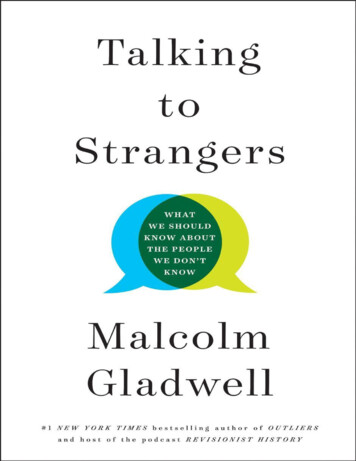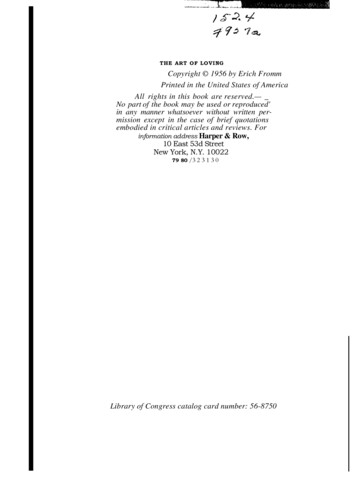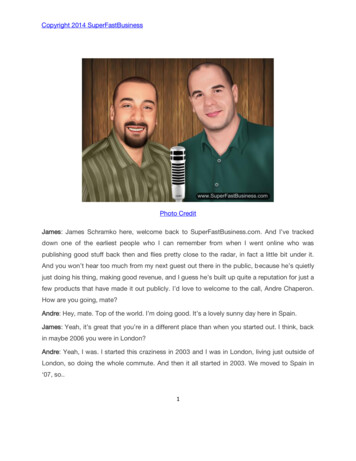
Transcription
Copyright 2019 by Malcolm GladwellCover design by Matt DorfmanAuthor photograph by Celeste SlomanCover copyright 2019 Hachette Book Group, Inc.Hachette Book Group supports the right to free expression and the value of copyright. The purpose of copyright is toencourage writers and artists to produce the creative works that enrich our culture.The scanning, uploading, and distribution of this book without permission is a theft of the author’s intellectual property.If you would like permission to use material from the book (other than for review purposes), please contactpermissions@hbgusa.com. Thank you for your support of the author’s rights.Little, Brown and CompanyHachette Book Group1290 Avenue of the Americas, New York, NY k.com/littlebrownandcompanyFirst ebook edition: September 2019Little, Brown and Company is a division of Hachette Book Group, Inc. The Little, Brown name and logo aretrademarks of Hachette Book Group, Inc.The publisher is not responsible for websites (or their content) that are not owned by the publisher.The Hachette Speakers Bureau provides a wide range of authors for speaking events. To find out more, go tohachettespeakersbureau.com or call (866) 376-6591.ISBN 978-0-316-53562-5E3-20190807-DA-NF
Table of ContentsCoverTitle PageCopyrightDedicationAuthor’s NoteIntroduction: “Step out of the car!”Part One: Spies and Diplomats: Two PuzzlesChapter One: Fidel Castro’s RevengeChapter Two: Getting to Know der FührerPart Two: Default to TruthChapter Three: The Queen of CubaChapter Four: The Holy FoolChapter Five: Case Study: The Boy in the ShowerPart Three: TransparencyChapter Six: The Friends FallacyChapter Seven: A (Short) Explanation of the Amanda Knox CaseChapter Eight: Case Study: The Fraternity PartyPart Four: LessonsChapter Nine: KSM: What Happens When the Stranger Is a Terrorist?Part Five: CouplingChapter Ten: Sylvia PlathChapter Eleven: Case Study: The Kansas City ExperimentsChapter Twelve: Sandra BlandDiscover More Malcolm GladwellAcknowledgmentsNotesPermissionsAbout the AuthorAlso by Malcolm Gladwell
For Graham Gladwell, 1934–2017
Explore book giveaways, sneak peeks, deals, and more.Tap here to learn more.
Author’s NoteMany years ago, when my parents came down to visit me in New York City, I decided to putthem up at the Mercer Hotel. It was a bit of mischief on my part. The Mercer is chic andexclusive, the kind of place where the famous and the fabulous stay. My parents—andparticularly my father—were oblivious to that kind of thing. My father did not watch television,or go to the movies, or listen to popular music. He would have thought People magazine was ananthropology journal. His areas of expertise were specific: mathematics, gardening, and theBible.I came to pick up my parents for dinner, and asked my father how his day had been.“Wonderful!” he said. Apparently he had spent the afternoon in conversation with a man in thelobby. This was fairly typical behavior for my father. He liked to talk to strangers.“What did you talk about?” I asked.“Gardening!” my father said.“What was his name?”“Oh, I have no idea. But the whole time people were coming up to him to take pictures andhave him sign little bits of paper.”If there is a Hollywood celebrity reading this who remembers chatting with a beardedEnglishman long ago in the lobby of the Mercer Hotel, please contact me.For everyone else, consider the lesson. Sometimes the best conversations between strangersallow the stranger to remain a stranger.
INTRODUCTION
“Step out of the car!”
1.In July 2015, a young African American woman named Sandra Bland drove from her hometownof Chicago to a little town an hour west of Houston, Texas. She was interviewing for a job atPrairie View A&M University, the school she’d graduated from a few years before. She was talland striking, with a personality to match. She belonged to the Sigma Gamma Rho sorority incollege, and played in the marching band. She volunteered with a seniors group. She regularlyposted short, inspirational videos on YouTube, under the handle “Sandy Speaks,” that oftenbegan, “Good morning, my beautiful Kings and Queens.”I am up today just praising God, thanking His name. Definitely thanking Him not just becauseit’s my birthday, but thanking Him for growth, thanking Him for the different things that Hehas done in my life over this past year. Just looking back at the twenty-eight years I have beenon this earth, and all that He has shown me. Even though I have made some mistakes, I havedefinitely messed up, He still loves me, and I want to let my Kings and Queens know outthere to that He still loves you too.Bland got the job at Prairie View. She was elated. Her plan was to get a master’s degree inpolitical science on the side. On the afternoon of July 10 she left the university to get groceries,and as she made a right turn onto the highway that rings the Prairie View campus, she was pulledover by a police officer. His name was Brian Encinia: white, short dark hair, thirty years old. Hewas courteous—at least at first. He told her that she had failed to signal a lane change. He askedher questions. She answered them. Then Bland lit a cigarette, and Encinia asked her to put it out.Their subsequent interaction was recorded by the video camera on his dashboard, and hasbeen viewed in one form or another several million times on YouTube.Bland: I’m in my car, why do I have to put out my cigarette?Encinia: Well, you can step on out now.Bland: I don’t have to step out of my car.Encinia: Step out of the car.Bland: Why am I Encinia: Step out of the car!Bland: No, you don’t have the right. No, you don’t have the right.Encinia: Step out of the car.Bland: You do not have the right. You do not have the right to do this.Encinia: I do have the right, now step out or I will remove you.Bland: I refuse to talk to you other than to identify myself. [crosstalk] I am getting removedfor a failure to signal?Encinia: Step out or I will remove you. I’m giving you a lawful order. Get out of the car nowor I’m going to remove you.Bland: And I’m calling my lawyer.
Bland and Encinia continue on for an uncomfortably long time. Emotions escalate.Encinia: I’m going to yank you out of here. [Reaches inside the car.]Bland: OK, you’re going to yank me out of my car? OK, all right.Encinia: [calling in backup] 2547.Bland: Let’s do this.Encinia: Yeah, we’re going to. [Grabs for Bland.]Bland: Don’t touch me!Encinia: Get out of the car!Bland: Don’t touch me. Don’t touch me! I’m not under arrest—you don’t have the right totake me out of the car.Encinia: You are under arrest!Bland: I’m under arrest? For what? For what? For what?Encinia: [To dispatch] 2547 County FM 1098. [inaudible] Send me another unit. [To Bland]Get out of the car! Get out of the car now!Bland: Why am I being apprehended? You’re trying to give me a ticket for failure Encinia: I said get out of the car!Bland: Why am I being apprehended? You just opened my—Encinia: I’m giving you a lawful order. I’m going to drag you out of here.Bland: So you’re threatening to drag me out of my own car?Encinia: Get out of the car!Bland: And then you’re going to [crosstalk] me?Encinia: I will light you up! Get out! Now! [Draws stun gun and points it at Bland.]Bland: Wow. Wow. [Bland exits car.]Encinia: Get out. Now. Get out of the car!Bland: For a failure to signal? You’re doing all of this for a failure to signal?Bland was arrested and jailed. Three days later, she committed suicide in her cell.
2.The Sandra Bland case came in the middle of a strange interlude in American public life. Theinterlude began in the late summer of 2014, when an eighteen-year-old black man namedMichael Brown was shot to death by a police officer in Ferguson, Missouri. He had just,allegedly, shoplifted a pack of cigars from a convenience store. The next several years saw onehigh-profile case after another involving police violence against black people. There were riotsand protests around the country. A civil rights movement, Black Lives Matter, was born. For atime, this was what Americans talked about. Perhaps you remember some of the names of thosein the news. In Baltimore, a young black man named Freddie Gray was arrested for carrying apocket knife and fell into a coma in the back of a police van. Outside Minneapolis, a young blackman named Philando Castile was pulled over by a police officer and inexplicably shot seventimes after handing over his proof of insurance. In New York City, a black man named EricGarner was approached by a group of police officers on suspicion that he was illegally sellingcigarettes, and was choked to death in the ensuing struggle. In North Charleston, South Carolina,a black man named Walter Scott was stopped for a nonfunctioning taillight, ran from his car, andwas shot to death from behind by a white police officer. Scott was killed on April 4, 2015.Sandra Bland gave him his own episode of “Sandy Speaks.”Good morning, my beautiful Kings and Queens. I am not a racist. I grew up in Villa Park,Illinois. I was the only black girl on an all-white cheerleading squad. Black people, you willnot be successful in this world until you learn how to work with white people. I want thewhite folks to really understand out there that black people are doing as much as we can andwe can’t help but get pissed off when we see situations where it’s clear that the black lifedidn’t matter. For those of you who question why he was running away, well goddamn, in thenews that we’ve seen of late, you can stand there and surrender to the cops and still be killed.Three months later, she too was dead.Talking to Strangers is an attempt to understand what really happened by the side of thehighway that day in rural Texas.Why write a book about a traffic stop gone awry? Because the debate spawned by that stringof cases was deeply unsatisfying. One side made the discussion about racism—looking down atthe case from ten thousand feet. The other side examined each detail of each case with amagnifying glass. What was the police officer like? What did he do, precisely? One side saw aforest, but no trees. The other side saw trees and no forest.Each side was right, in its own way. Prejudice and incompetence go a long way towardexplaining social dysfunction in the United States. But what do you do with either of thosediagnoses aside from vowing, in full earnestness, to try harder next time? There are bad cops.There are biased cops. Conservatives prefer the former interpretation, liberals the latter. In theend the two sides canceled each other out. Police officers still kill people in this country, butthose deaths no longer command the news. I suspect that you may have had to pause for amoment to remember who Sandra Bland was. We put aside these controversies after a decent
interval and moved on to other things.I don’t want to move on to other things.
3.In the sixteenth century, there were close to seventy wars involving the nations and states ofEurope. The Danes fought the Swedes. The Poles fought the Teutonic Knights. The Ottomansfought the Venetians. The Spanish fought the French—and on and on. If there was a pattern tothe endless conflict, it was that battles overwhelmingly involved neighbors. You fought theperson directly across the border, who had always been directly across your border. Or youfought someone inside your own borders: the Ottoman War of 1509 was between two brothers.Throughout the majority of human history, encounters—hostile or otherwise—were rarelybetween strangers. The people you met and fought often believed in the same God as you, builttheir buildings and organized their cities in the same way you did, fought their wars with thesame weapons according to the same rules.But the sixteenth century’s bloodiest conflict fit none of those patterns. When the Spanishconquistador Hernán Cortés met the Aztec ruler Montezuma II, neither side knew anything aboutthe other at all.Cortés landed in Mexico in February of 1519 and slowly made his way inland, advancing onthe Aztec capital of Tenochtitlán. When Cortés and his army arrived, they were in awe.Tenochtitlán was an extraordinary sight—far larger and more impressive than any of the citiesCortés and his men would have known back in Spain. It was a city on an island, linked to themainland with bridges and crossed by canals. It had grand boulevards, elaborate aqueducts,thriving marketplaces, temples built in brilliant white stucco, public gardens, and even a zoo. Itwas spotlessly clean—which, to someone raised in the filth of medieval European cities, wouldhave seemed almost miraculous.“When we saw so many cities and villages built in the water and other great towns on dryland, we were amazed and said that it was like the enchantments,” one of Cortés’s officers,Bernal Díaz del Castillo, recalled. “And some of our soldiers even asked whether the things thatwe saw were not a dream? I do not know how to describe it, seeing things as we did that hadnever been heard of or seen before, not even dreamed about.”The Spanish were greeted at the gates of Tenochtitlán by an assembly of Aztec chiefs, thentaken to Montezuma. He was a figure of almost surreal grandeur, carried on a litter embroideredwith gold and silver and festooned with flowers and precious stones. One of his courtiersadvanced before the procession, sweeping the ground. Cortés dismounted from his horse.Montezuma was lowered from his litter. Cortés, like the Spaniard he was, moved to embrace theAztec leader—only to be restrained by Montezuma’s attendants. No one embraced Montezuma.Instead, the two men bowed to each other.“Art thou not he? Art thou Montezuma?”Montezuma answered: “Yes, I am he.”No European had ever set foot in Mexico. No Aztec had ever met a European. Cortés knewnothing about the Aztecs, except to be in awe of their wealth and the extraordinary city they hadbuilt. Montezuma knew nothing of Cortés, except that he had approached the Aztec kingdomwith great audacity, armed with strange weapons and large, mysterious animals—horses—thatthe Aztecs had never seen before.
Is it any wonder why the meeting between Cortés and Montezuma has fascinated historiansfor so many centuries? That moment—500 years ago—when explorers began traveling acrossoceans and undertaking bold expeditions in previously unknown territory, an entirely new kindof encounter emerged. Cortés and Montezuma wanted to have a conversation, even though theyknew nothing about the other. When Cortés asked Montezuma, “Art thou he?,” he didn’t saythose words directly. Cortés spoke only Spanish. He had to bring two translators with him. Onewas an Indian woman named Malinche, who had been captured by the Spanish some monthsbefore. She knew the Aztec language Nahuatl and Mayan, the language of the Mexican territorywhere Cortés had begun his journey. Cortés also had with him a Spanish priest named Gerónimodel Aguilar, who had been shipwrecked in the Yucatán and learned Mayan during his sojournthere. So Cortés spoke to Aguilar in Spanish. Aguilar translated into Mayan for Malinche. AndMalinche translated the Mayan into Nahuatl for Montezuma—and when Montezuma replied,“Yes, I am,” the long translation chain ran in reverse. The kind of easy face-to-face interactionthat each had lived with his entire life had suddenly become hopelessly complicated.1Cortés was taken to one of Montezuma’s palaces—a place that Aguilar described later ashaving “innumerable rooms inside, antechambers, splendid halls, mattresses of large cloaks,pillows of leather and tree fibre, good eiderdowns, and admirable white fur robes.” After dinner,Montezuma rejoined Cortés and his men and gave a speech. Immediately, the confusion began.The way the Spanish interpreted Montezuma’s remarks, the Aztec king was making anastonishing concession: he believed Cortés to be a god, the fulfillment of an ancient prophecythat said an exiled deity would one day return from the east. And he was, as a result,surrendering to Cortés. You can imagine Cortés’s reaction: this magnificent city was noweffectively his.But is that really what Montezuma meant? Nahuatl, the language of the Aztecs, had areverential mode. A royal figure such as Montezuma would speak in a kind of code, according toa cultural tradition in which the powerful projected their status through an elaborate falsehumility. The word in Nahuatl for a noble, the historian Matthew Restall points out, is all butidentical to the word for child. When a ruler such as Montezuma spoke of himself as small andweak, in other words, he was actually subtly drawing attention to the fact that he was esteemedand powerful.“The impossibility of adequately translating such language is obvious,” Restall writes:The speaker was often obliged to say the opposite of what was really meant. True meaningwas embedded in the use of reverential language. Stripped of these nuances in translation, anddistorted through the use of multiple interpreters not only was it unlikely that a speech suchas Montezuma’s would be accurately understood, but it was probable that its meaning wouldbe turned upside down. In that case, Montezuma’s speech was not his surrender; it was hisacceptance of a Spanish surrender.You probably remember from high-school history how the encounter between Cortés andMontezuma ended. Montezuma was taken hostage by Cortés, then murdered. The two sides wentto war. As many as twenty million Aztecs perished, either directly at the hands of the Spanish orindirectly from the diseases they had brought with them. Tenochtitlán was destroyed. Cortés’sforay into Mexico ushered in the era of catastrophic colonial expansion. And it also introduced a
new and distinctly modern pattern of social interaction. Today we are now thrown into contactall the time with people whose assumptions, perspectives, and backgrounds are different fromour own. The modern world is not two brothers feuding for control of the Ottoman Empire. It isCortés and Montezuma struggling to understand each other through multiple layers oftranslators. Talking to Strangers is about why we are so bad at that act of translation.Each of the chapters that follows is devoted to understanding a different aspect of the strangerproblem. You will have heard of many of the examples—they are taken from the news. AtStanford University in northern California, a first-year student named Brock Turner meets awoman at a party, and by the end of the evening he is in police custody. At Pennsylvania StateUniversity, the former assistant coach of the school’s football team, Jerry Sandusky, is foundguilty of pedophilia, and the president of the school and two of his top aides are found to becomplicit in his crimes. You will read about a spy who spent years undetected at the highestlevels of the Pentagon, about the man who brought down hedge-fund manager Bernie Madoff,about the false conviction of the American exchange student Amanda Knox, and about thesuicide of the poet Sylvia Plath.In all of these cases, the parties involved relied on a set of strategies to translate one another’swords and intentions. And in each case, something went very wrong. In Talking to Strangers, Iwant to understand those strategies—analyze them, critique them, figure out where they camefrom, find out how to fix them. At the end of the book I will come back to Sandra Bland, becausethere is something about the encounter by the side of the road that ought to haunt us. Think abouthow hard it was. Sandra Bland was not someone Brian Encinia knew from the neighborhood ordown the street. That would have been easy: Sandy! How are you? Be a little more careful nexttime. Instead you have Bland from Chicago and Encinia from Texas, one a man and the other awoman, one white and one black, one a police officer and one a civilian, one armed and the otherunarmed. They were strangers to each other. If we were more thoughtful as a society—if wewere willing to engage in some soul-searching about how we approach and make sense ofstrangers—she would not have ended up dead in a Texas jail cell.But to start, I have two questions—two puzzles about strangers—beginning with a story toldby a man named Florentino Aspillaga years ago in a German debriefing room.1The idea that Montezuma considered Cortés a god has been soundly debunked by the historian Camilla Townsend,among others. Townsend argues that it was probably just a misunderstanding, following from the fact that the Nahua usedthe word teotl to refer to Cortés and his men, which the Spanish translated as god. But Townsend argues that they used thatword only because they “had to call the Spaniards something, and it was not at all clear what that something should be. Inthe Nahua universe as it had existed up until this point, a person was always labeled as being from a particular village orcity-state, or, more specifically, as one who filled a given social role (a tribute collector, prince, servant). These new peoplefit nowhere.”
Part One
Spies and Diplomats:Two Puzzles
CHAPTER ONE
Fidel Castro’s Revenge
1.Florentino Aspillaga’s final posting was in Bratislava, in what was then Czechoslovakia. It was1987, two years before the Iron Curtain fell. Aspillaga ran a consulting company called CubaTecnica, which was supposed to have something to do with trade. It did not. It was a front.Aspillaga was a high-ranking officer in Cuba’s General Directorate of Intelligence.Aspillaga had been named intelligence officer of the year in the Cuban spy service in 1985.He had been given a handwritten letter of commendation from Fidel Castro himself. He hadserved his country with distinction in Moscow, Angola, and Nicaragua. He was a star. InBratislava, he ran Cuba’s network of agents in the region.But at some point during his steady ascent through the Cuban intelligence service, he grewdisenchanted. He watched Castro give a speech in Angola, celebrating the Communist revolutionthere, and had been appalled by the Cuban leader’s arrogance and narcissism. By the time of hisposting to Bratislava, in 1986, those doubts had hardened.He planned his defection for June 6, 1987. It was an elaborate inside joke. June 6 was theanniversary of the founding of the Cuban Ministry of the Interior—the all-powerful body thatadministered the country’s spy services. If you worked for the General Directorate ofIntelligence, you would ordinarily celebrate on June 6. There would be speeches, receptions,ceremonies in honor of Cuba’s espionage apparatus. Aspillaga wanted his betrayal to sting.He met up with his girlfriend Marta in a park in downtown Bratislava. It was Saturdayafternoon. She was Cuban as well, one of thousands of Cubans who were guest workers in Czechfactories. Like all Cubans in her position, her passport was held at the Cuban government officesin Prague. Aspillaga would have to smuggle her across the border. He had a government-issuedMazda. He removed the spare tire from the trunk, drilled an air hole in the floor, and told her toclimb inside.Eastern Europe, at that point, was still walled off from the rest of the continent. Travelbetween East and West was heavily restricted. But Bratislava was only a short drive fromVienna, and Aspillaga had made the trip before. He was well known at the border and carried adiplomatic passport. The guards waved him through.In Vienna, he and Marta abandoned the Mazda, hailed a taxi, and presented themselves at thegates to the United States Embassy. It was Saturday evening. The senior staff was all at home.But Aspillaga did not need to do much to get the guard’s attention: “I am a case officer fromCuban Intelligence. I am an intelligence comandante.”In the spy trade, Aspillaga’s appearance at the Vienna embassy is known as a walk-in. Anofficial from the intelligence service of one country shows up, unexpectedly, on the doorstep ofthe intelligence service of another country. And Florentino “Tiny” Aspillaga was one of the greatwalk-ins of the Cold War. What he knew of Cuba—and its close ally, the Soviet Union—was sosensitive that twice after his defection his former employers at the Cuban spy service tracked himdown and tried to assassinate him. Twice, he slipped away. Only once since has Aspillaga beenspotted. It was by Brian Latell, who ran the CIA’s Latin American office for many years.Latell got a tip from an undercover agent who was acting as Aspillaga’s go-between. He metthe go-between at a restaurant in Coral Gables, just outside Miami. There he was given
instructions to meet in another location, closer to where Aspillaga was living under his newidentity. Latell rented a suite in a hotel, somewhere anonymous, and waited for Tiny to arrive.“He’s younger than me. I’m seventy-five. He’s by now probably in his upper sixties,” Latellsaid, remembering the meeting. “But he’s had terrible health problems. I mean, being a defector,living with a new identity, it’s tough.”Even in his diminished state, though, it was obvious what Aspillaga must have been like as ayounger man, Latell says: charismatic, slender, with a certain theatricality about him—a taste forrisks and grand emotional gestures. When he came into the hotel suite, Aspillaga was carrying abox. He put it down on the table and turned to Latell.“This is a memoir that I wrote soon after I defected,” he said. “I want you to have this.”Inside the box, in the pages of Aspillaga’s memoir, was a story that made no sense.
2.After his dramatic appearance at the American embassy in Vienna, Aspillaga was flown to adebriefing center at a U.S. Army base in Germany. In those years, American intelligenceoperated out of the United States Interests Section in Havana, under the Swiss flag. (The Cubandelegation had a similar arrangement in the United States.) Before his debriefing began,Aspillaga said, he had one request: he wanted the CIA to fly in one of the former Havana stationchiefs, a man known to Cuban intelligence as “el Alpinista,” the Mountain Climber.The Mountain Climber had served the agency all over the world. After the Berlin Wall fell,files retrieved from the KGB and the East German secret police revealed that they had taught acourse on the Mountain Climber to their agents. His tradecraft was impeccable. Once, Sovietintelligence officers tried to recruit him: they literally placed bags of money in front of him. Hewaved them off, mocked them. The Mountain Climber was incorruptible. He spoke Spanish likea Cuban. He was Aspillaga’s role model. Aspillaga wanted to meet him face-to-face.“I was on an assignment in another country when I got a message to rush to Frankfurt,” theMountain Climber remembers. (Though long retired from the CIA, he still prefers to beidentified only by his nickname.) “Frankfurt is where we had our defector processing center.They told me a fellow had walked into an embassy in Vienna. He had driven out ofCzechoslovakia with his girlfriend in the trunk of his car, walked in, and insisted on speaking tome. I thought it was kind of crazy.”El Alpinista went straight to the debriefing center. “I found four case officers sitting in theliving room,” he remembers. “They told me Aspillaga was back in the bedroom making lovewith his girlfriend, as he had constantly since he arrived at the safe house. Then I went in andspoke to him. He was lanky, poorly dressed, as Eastern Europeans and Cubans tended to be backthen. A little sloppy. But it was immediately evident that he was a very smart guy.”When he walked in, the Mountain Climber didn’t tell Aspillaga who he was. He was trying tobe cagey; Aspillaga was an unknown quantity. But it was only a matter of minutes beforeAspillaga figured it out. There was a moment of shock, laughter. The two men hugged, Cubanstyle.“We talked for five minutes before we started into the details. Whenever you are debriefingone of those guys, you need someone that proves their bona fides,” the Mountain Climber said.“So I just basically asked him what he could tell me about the [Cuban intelligence] operation.”It was then that Aspillaga revealed his bombshell, the news that had brought him from behindthe Iron Curtain to the gates of the Vienna embassy. The CIA had a network of spies insideCuba, whose dutiful reports to their case officers helped shape America’s understanding of itsadversary. Aspillaga named one of them and said, “He’s a double agent. He works for us.” Theroom was stunned. They had no idea. But Aspillaga kept going. He named another spy. “He’s adouble too.” Then another, and another. He had names, details, chapter and verse. That guy yourecruited on the ship in Antwerp. The little fat guy with the mustache? He’s a double. That otherguy, with a limp, who works in the defense ministry? He’s a double. He continued on like thatuntil he had listed dozens of names—practically the entire U.S. roster of secret agents insideCuba. They were all working for Havana, spoon-feeding the CIA information cooked up by the
Cubans themselves.“I sat there and took notes,” the Mountain Climber said. “I tried not to betray any emotion.That’s what we’re taught. But my heart was racing.”Aspillaga was talking about the Mountain Climber’s people, the spies he’d worked with whenhe had been posted to Cuba as a young and ambitious intelligence officer. When he’d firstarrived in Havana, the Mountain Climber had made a point of working his sources aggressively,mining them for information. “The thing is, if you have an agent who is in the office of thepresident of whatever country, but you can’t communicate with him, that agent is worthless,” theMountain Climber said. “My feeling was, let’s communicate and get some value, rather thanwaiting six months or a year until he puts up someplace else.” But now the whole exercise turnedout to have been a sham. “I must admit that I disliked Cuba so much that I derived much pleasurefrom pulling the wool over their eyes,” he said, ruefully. “But it turns out th
2. The Sandra Bland case came in the middle of a strange interlude in American public life. The interlude began in the late











